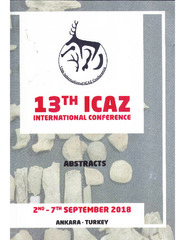Приказ основних података о документу
Exploatation of freshwater mussels in the late prehistory of Southeast Europe: Case study of an Early Bronze Age settlement in Kostolac (Eastern Serbia)
| dc.creator | Vuković Bogdanović, Sonja | |
| dc.creator | Marković, Dimitrije | |
| dc.creator | Danković, Ilija | |
| dc.creator | Dimitrijević, Vesna | |
| dc.date.accessioned | 2024-01-03T14:45:52Z | |
| dc.date.available | 2024-01-03T14:45:52Z | |
| dc.date.issued | 2018 | |
| dc.identifier.uri | http://rai.ai.ac.rs/handle/123456789/1288 | |
| dc.description.abstract | Freshwater shell remains in late prehistoric faunal assemblages of Southeastern Europe have often been neglected and usually just counted, while their species level was rarely determined. Based on ethnographic data, they were usually interpreted as remnants of additional food resources, but also as food for pigs and as fish baits. Several pits filled with unionid shells have been dug up in 2012, in the course of protective archaeological excavations of late prehistoric settlements located at the shore of the River Klepečka, near its confluence with the Danube (in the surroundings of the later Roman city of Viminacium). According to other archaeological finds, the pits were dated to the Early Bronze Age. The assemblage of more than 1000 valves offered an opportunity for a detailed morphometric study of mollusk remains. The research included taxonomic identification, specific measurements of each valve and recording of taphonomic data, such as shell color, fragmentation and artificial modifications. Three species have been identified: Unio crassus, Unio pictorum, and Unio tumidus. We discuss whether the species significantly differ according to their length, breadth and height, as well as morphological traits of the hinge area. According to contextual and overall distribution we will discuss possible cultural preference towards these three species in prehistory. Finally, based on contextual data and taphonomic features, we will discuss their purpose and significance within the studied settlement. The results will be placed in regional and temporal context in order to suggest freshwater shell significance in the life of people who occupied Southeastern Europe in late prehistory. | sr |
| dc.language.iso | en | sr |
| dc.publisher | International Council for Zooaarchaeology | sr |
| dc.publisher | Middle East Technical University | sr |
| dc.relation | IRS - Viminacijum, rimski grad i legijski vojni logor - istraživanje materijalne i duhovne kulture, stanovništva, primenom najsavremenijih tehnologija daljinske detekcije, geofizike, GIS-a, digitalizacije i 3D vizualizacije | sr |
| dc.rights | openAccess | sr |
| dc.source | 13th ICAZ International Conference. 02 – 07. September 2018. Ankara - Turkey, Abstracts | sr |
| dc.subject | Unio shells | sr |
| dc.subject | shell biometry | sr |
| dc.subject | shell taphonomy | sr |
| dc.subject | suplementary food | sr |
| dc.subject | Late Prehistory | sr |
| dc.subject | Serbia | sr |
| dc.subject | Nad Klepečkom | sr |
| dc.title | Exploatation of freshwater mussels in the late prehistory of Southeast Europe: Case study of an Early Bronze Age settlement in Kostolac (Eastern Serbia) | sr |
| dc.type | conferenceObject | sr |
| dc.rights.license | ARR | sr |
| dc.citation.epage | 26 | |
| dc.citation.spage | 26 | |
| dc.identifier.fulltext | http://rai.ai.ac.rs/bitstream/id/2182/bitstream_2182.pdf | |
| dc.identifier.rcub | https://hdl.handle.net/21.15107/rcub_rai_1288 | |
| dc.type.version | publishedVersion | sr |


